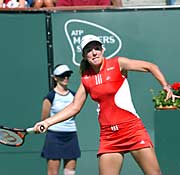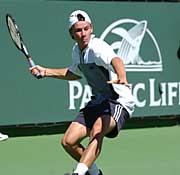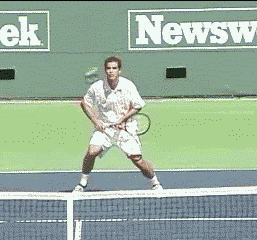|
TennisOne Lessons
Palms Down – What’s Up with That by Jim McLennan Photos: Bill Putnam
Baseball pitchers are known to place weights in their gloves. Presumably a heavier glove assists somehow in generating velocity on the pitch. Some years ago I heard that Vic Braden was marketing “weighted sweatbands for the non dominant arm.” Again, presumably so the added weight to the non dominant side would add “something” to the forehand. Observe any of the following examples and you notice that the player turns both palms down in the initial preparation, and somehow as the non dominant arm moves during the swing that particular palm remains down. Quarterbacks draw the ball back for a forward pass, again palms down. The mechanics of pitching checklist recommends the starting position with palms down and elbows up and away (and this looks exactly like the opening move on the forehand). Finally, and this is an observation with no attendant explanation, when balancing on an Indo Board, the manufacturer recommends a position with palms down and elbows up and away. This may have something to do with rotational mechanics on the forehand.
Back in the day (the linear era) the standard preparation was to point the non dominant arm toward the target, and to catch the racquet with this hand as the follow through flowed toward the target. A quiet and pointing left side provided balance, perhaps precision, but truly little else. And it must be said, neither the quarterback or pitcher point their non dominant arm to the target, and neither would ever catch their throwing arm out in front with their non dominant arm. Well throwing (baseball or football) has a strong rotational element, and truly here the more rotation the better.
So to superimpose rotational throwing mechanics on the forehand (as all the modern players do) the initial move places palms down and elbows up and away. Then as the stroke begins there is a one-two, where the left arm extends out toward the target and then finishes against the body as the right arm is "flung" into the hit. Next time you are at the courts, make note of the non dominant arms you see. When players let this arm hang quietly at their side, they are essentially playing with half their body, and it will appear just so, as a somewhat constricted arm swing. Contrast with some good forehands you might find, and you will note (I predict) an active non dominant side – initially positioned palm down and elbow flexed – then extending rapidly – and finishing yet again palm down and elbow flexed. Experiment, you might like it. Your comments are welcome. Let us know what you think about Jim McLennan's article by emailing us here at TennisOne.
|
||||||||||






